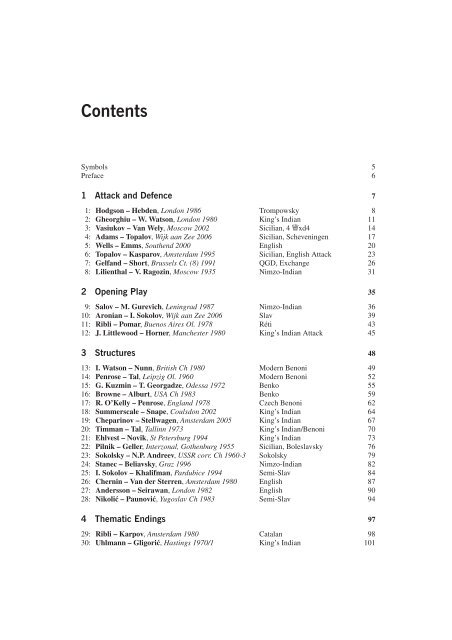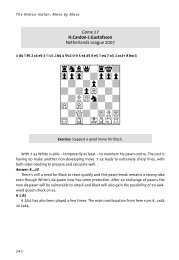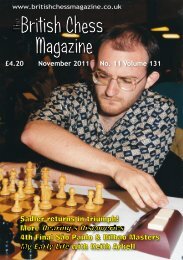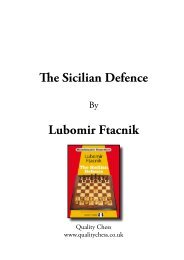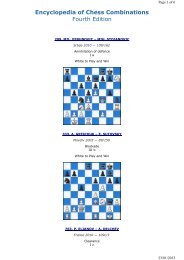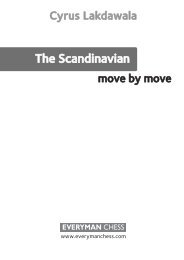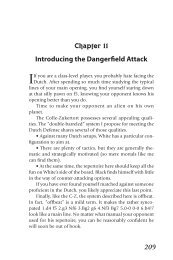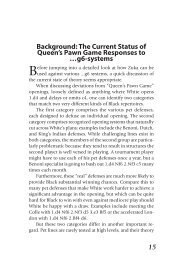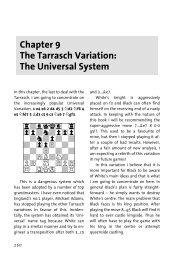You also want an ePaper? Increase the reach of your titles
YUMPU automatically turns print PDFs into web optimized ePapers that Google loves.
CONTENTSContentsSymbols 5Preface 61 Attack and Defence 71: Hodgson – Hebden, London 1986 Trompowsky 82: Gheorghiu – W. Watson, London 1980 King’s Indian 113: Vasiukov – Van Wely, Moscow 2002 Sicilian, 4 Ëxd4 144: Adams – Topalov, Wijk aan Zee 2006 Sicilian, Scheveningen 175: Wells – Emms, Southend 2000 English 206: Topalov – Kasparov, Amsterdam 1995 Sicilian, English Attack 237: Gelfand – Short, Brussels Ct. (8) 1991 QGD, Exchange 268: Lilienthal – V. Ragozin, Moscow 1935 Nimzo-Indian 312 Opening Play 359: Salov – M. Gurevich, Leningrad 1987 Nimzo-Indian 3610: Aronian – I. Sokolov, Wijk aan Zee 2006 Slav 3911: Ribli – Pomar, Buenos Aires Ol. 1978 Réti 4312: J. Littlewood – Horner, Manchester 1980 King’s Indian Attack 453 Structures 4813: I. Watson – Nunn, British Ch 1980 Modern Benoni 4914: Penrose – Tal, Leipzig Ol. 1960 Modern Benoni 5215: G. Kuzmin – T. Georgadze, Odessa 1972 Benko 5516: Browne – Alburt, USA Ch 1983 Benko 5917: R. O’Kelly – Penrose, England 1978 Czech Benoni 6218: Summerscale – Snape, Coulsdon 2002 King’s Indian 6419: Cheparinov – Stellwagen, Amsterdam 2005 King’s Indian 6720: Timman – Tal, Tallinn 1973 King’s Indian/Benoni 7021: Ehlvest – Novik, St Petersburg 1994 King’s Indian 7322: Pilnik – Geller, Interzonal, Gothenburg 1955 Sicilian, Boleslavsky 7623: Sokolsky – N.P. Andreev, USSR corr. Ch 1960-3 Sokolsky 7924: Stanec – Beliavsky, Graz 1996 Nimzo-Indian 8225: I. Sokolov – Khalifman, Pardubice 1994 Semi-Slav 8426: Chernin – Van der Sterren, Amsterdam 1980 English 8727: Andersson – Seirawan, London 1982 English 9028: Nikoli‡ – Paunovi‡, Yugoslav Ch 1983 Semi-Slav 944 Thematic Endings 9729: Ribli – Karpov, Amsterdam 1980 Catalan 9830: Uhlmann – Gligori‡, Hastings 1970/1 King’s Indian 101
4 50 WAYS TO WIN AT CHESS31: D. Howell – Kramnik, London 2002 Ruy Lopez 10432: Kosteniuk – P.H. Nielsen, Hastings 2002/3 Caro-Kann 10833: Sveshnikov – Novikov, USSR Rapid Cup 1988 Sicilian, 2 c3 1125 Other Aspects of Strategy 11534: Fischer – Uhlmann, Buenos Aires 1960 French 11635: Dorfman – Bronstein, USSR Ch 1975 Old Indian 12036: Mamedyarov – Brodsky, Russian Clubs Ch 2006 Queen’s Pawn 12337: T. Bennett – Keene, England 1970 Modern 12638: Kramnik – Vaganian, Horgen 1995 Queen’s Indian 12839: Lilienthal – Botvinnik, USSR Ch 1940 Queen’s Indian 13140: P. Johansson – Giddins, Gausdal 1995 Bogo-Indian 13441: Petrosian – Gheorghiu, Moscow 1967 English Opening 13742: Carlsen – Vescovi, Wijk aan Zee 2006 Sicilian, Taimanov 14043: Stein – Spassky, USSR Ch 1962 Ruy Lopez 1436 Endgame Themes 14644: Miles – Larsen, Tilburg 1978 Queen’s Indian 14745: L’Ami – Mamedyarov, World Junior Ch 2005 Ruy Lopez 15046: Kramnik – Leko, Dortmund 2006 Nimzo-Indian 15547: Djurhuus – Sargissian, Turin Ol. 2006 Ruy Lopez 15848: Bronstein – Alexander, Hastings 1953/4 Dutch 1617 Psychology in Action 16649: M. Gurevich – Short, Interzonal, Manila 1990 French 16750: Kasparov – Karpov, Seville World Ch (24) 1987 Réti 170Index of Players 174Index of Openings 175
ATTACK AND DEFENCE 17Game 4Michael Adams – Veselin TopalovWijk aan Zee 2006Sicilian Defence, Classical ScheveningenThe present game shows a kingside attack in conditions where both players have castled kingside.In such a case, a pawn-storm is much less likely to be effective, since the attacker would risk exposinghis own king as much as the opponent’s. Instead, the attack is usually carried out by pieces, ashere.1 e4 c5 2 Ìf3 d6 3 d4 cxd4 4 Ìxd4 Ìf6 5Ìc3 a6 6 Íe2With this move, White eschews the sharperlines of the Najdorf, beginning with such movesas 6 Íg5 and 6 Íe3. Instead, he concentrateson sound development, postponing the weightof the struggle to the middlegame. In the immediatefuture, he will play 0-0, Íe3 and f4.6...e6Black chooses to go into a Scheveningenstyleset-up, with his two central pawns on d6and e6. The pure Najdorf interpretation is 6...e5,accepting the backward d-pawn in return forcontrol of the squares d4 and f4. We saw a classicexample of a similar strategy working forBlack in the game Matulovi‡-Fischer, examinedin 50ECL (Game 30). Although 6...e5 istheoretically perfectly sound after 6 Íe2, in recentyears, the more flexible 6...e6 has becomemore popular at GM level, largely due to the influenceof Garry Kasparov.7 0-0 Íe7 8 a4This is a sign of White’s relatively restrainedplan. Rather than launching a violent attack onBlack’s king with g4-g5, as he would do if hehad castled queenside, he intends to build uphis attack in more patient fashion. As part ofthat approach, he prefers to limit Black’s counterplayon the queenside, by holding back theadvance ...b5.8...Ìc6 9 Íe3 0-0 10 f4 Ëc7 11 Êh1 Îe8(D)This is the modern way to play the black position,following the example of Kasparov. Blackintends to drop his bishop back to f8, defendinghis king. In the longer term, he hopes one day tobreak out with the central pawn-thrust ...d5,which will release the energy of his pieces. Inthis case, the rook on e8 is likely to proveWr+l+r+k++pw-vpzpp+nzps-++-+-+-+-P+-SPZ-++-S-V-+--ZP+L+PZT-+Q+R+Keffective on the e-file. Black’s position is verysimilar to the Hedgehog formation that we examinedin Uhlmann-Bönsch, in 50ECL (Game41). As that game demonstrated so clearly,Black’s ‘coiled spring’ position contains theseeds of a devastating counterattack if Whiteover-extends himself in the search for attackingchances on the kingside.Nonetheless, the move 11...Îe8 does haveits drawbacks. In particular, Black leaves thef7-square undefended, and as we shall see laterin the game, this becomes a factor when Whitebreaks with e5.12 Íf3 Íf8 13 Ëd2 Ìa513...Îb8 has also been played here, and mayeven be more accurate. In the present game,Black plays a number of very natural and normal-lookingmoves in the early middlegame,but emerges with a difficult position.14 b3 Îb8The purpose of this move is to prepare15...b6, and then develop his bishop to b7 (ofcourse, the immediate 14...b6? would lose materialafter 15 e5). The bishop could just go tod7 immediately, but it would be less active onthat square. From b7, it puts pressure on White’se4-pawn, and it also allows the f6-knight to
18 50 WAYS TO WIN AT CHESSretreat to d7, if attacked by a later g4-g5 thrust.However, the drawback to Black’s plan is thathis development takes longer to complete, andAdams later suggested that he should perhapssettle for 14...Íd7 and 15...Îac8, completinghis mobilization.15 Îad1 (D)B-tl+rvk++pw-+pzpp+-zps-+s-+-+-+-P+-SPZ-++PS-VL+--+PW-+PZ+-+R+R+K15...Ìc6The consistent move here is 15...b6, but thisallows White to break in the centre in energeticstyle by 16 e5!. A typical variation, givenby Adams, would be 16...dxe5 17 fxe5 Ìd7(17...Ëxe5? 18 Íf4 costs Black the exchange)18 Íh5 Ìxe5 (or 18...g6 19 Ëf2) 19 Íf4 g6 20Ìe4, with dangerous threats for the pawn. Notehow in this variation, White is able to bringpressure to bear down the f-file, against the f7-square, thereby illustrating the point made inthe note to 11...Îe8.In view of these lines, Topalov felt that15...b6 was too risky, but in this case, his plan of14...Îb8 must be considered to have been inaccurate,since its whole point was to allow 15...b6and 16...Íb7. This is a good example of how apparentlysmall tactical points can influence strategy.In principle, placing Black’s bishop on b7 isstrategically a good idea, but since it proves tacticallyimpossible to carry out, the whole planbeginning 14...Îb8 is called into question.16 Íf2Adams pointed out that 16 Ëf2! would havebeen stronger here, once again utilizing Black’sweaknesses on the f-file. The threat of 17 e5would then have been awkward to meet. However,the move chosen is also quite good. Whiteintends to bring his bishop to h4, after whichthe threat of e5 gains in strength. Black’s nextmove is designed to prevent this.16...Ìd7 17 Íg3 Ìxd4 18 Ëxd4 b5 19axb5 axb5 20 b4This move is unusual in such positions, sinceit creates weaknesses down the c-file. However,in this particular position, it is more importantto secure the position of White’s knight on c3.White is ready to break with e5, after which thec-file weaknesses will become secondary.20...g6?!This turns out to be just about the decisivemistake. Black was already in trouble, and inAdams’s view, he had no choice but to go intoan inferior ending with 20...Ëc4. White retainsthe better chances after 21 Ëxc4 bxc4 22 b5,but his advantage is significantly less than inthe game.21 e5 d5 (D)W-tl+rvk++-wn+p+p-+-+p+p++p+pZ-+--Z-W-Z-++-S-+LV--+P+-+PZ+-+R+R+K22 f5!Setting in motion what proves to be a winningattack. Black has little choice but to capture,since it is already too late for 22...Ëc4,which loses to 23 fxe6 fxe6 24 Ìxd5! Ëxd4(24...exd5? 25 Íxd5+ costs Black his queen) 25Îxd4 exd5 26 Íxd5+ Êh8 27 Íf7 Îe7 28 e6.22...gxf5 23 Ìxd5! Ëc4Capturing by 23...exd5? loses at once to 24e6; e.g., 24...Ëb6 25 exf7+ Êxf7 26 Íh5+,with a winning attack.24 Ëd2In the middle of an attack, it is natural to keepthe queens on the board, but the computer pointsout that 24 Ìf6+ is also very strong. After24...Ìxf6 25 exf6, the b8-rook is very short ofsquares, and after the further moves 25...Ëxd426 Îxd4 Îb6 27 Îe1, Black is terribly tied up.Nonetheless, Adams’s move is more thematicand pursues the attack on the black king. Themain point is that 24...exd5 loses to 25 Ëg5+
ATTACK AND DEFENCE 19Êh8 26 Íxd5 Ëg4 27 Ëxg4 fxg4 28 Íxf7.This explains Black’s next move, which preventsthe check on g5.24...h6 (D)W-tl+rvk++-+n+p+--+-+p+-z+p+NZp+--Zq+-+-++-+-+LV--+PW-+PZ+-+R+R+K25 h3!A very surprising quiet move in the middleof a raging attack, and also a nice echo ofBlack’s previous move. White simply takes theg4-square away from Black’s queen, as well asmaking luft for his own king. Usually, the attackerwould not have time for such luxuries inthe middle of an attack, as maintaining the initiativeand keeping the defender off-balancewith continual threats is usually the order of theday. Here, however, Adams has appreciatedthat Black does not have any obvious defensivemoves.25...exd5There is nothing else. 25...Íg7 26 Ìf6+Ìxf6 (or 26...Íxf6 27 exf6, when both b8 andh6 are hanging) 27 exf6 attacks both b8 and g7,whilst 25...Êh8 26 Ìf6 Ìxf6 27 exf6 e5 28Íd5 Ëc7 (28...Ëxb4 29 Íxf7 traps the rook)29 Ëe2 gives White a devastating attack, for nomaterial investment. Topalov decides he may aswell have a piece to suffer for.26 Íxd5 Ëxb4 27 c3 Ëc5Giving back the piece by 27...Ëe7 28 Îxf5Ìxe5! 29 Îxe5 Íe6 was a slightly tougher defence,although White is still winning with accurateplay. Adams then gives 30 Íxe6 fxe6 31Ëe2 as the strongest, when the exposed blackking and weakness on e6 will cost him the game.28 Îxf5 Îe6 (D)A desperate attempt to block the a2-g8 diagonal,at the cost of the exchange. Instead,28...Îe7 29 e6 is decisive, since the b8-rook isonce again en prise.W-tl+-vk++-+n+p+--+-+r+-z+pwLZR+--+-+-+-++-Z-+-VP-+-W-+P++-+R+-+K29 Îxf7!Crashing through decisively, and much betterthan the routine capture of the exchange on e6.29...Ìb629...Êxf7 30 Ëf4+ Êe8 (or 30...Êe7 31Íh4+ winning) 31 Íxe6 is crushing.30 Îdf1Good enough, but Adams points out that30 Ëf4! was even better, with the point that30...Ìxd5 loses to 31 Îxd5!.30...Ìxd530...Íg7 31 Ëf4 Ìxd5 32 Ëg4 mates.31 Îxf8+ Ëxf8 32 Îxf8+ Êxf8 33 Ëxd5The attack has triumphed. Not only doesWhite have a material advantage of Ë+2Ï vs2Î, but he also has an ongoing attack againstthe highly exposed black king. The rest is just amopping-up exercise.33...Êe8 34 Íh4 Íd7 35 Íf6 b4 36 Ëe4Adams himself pointed out that 36 Ëd3!wins even more quickly, but in some timetrouble,he preferred simply to annex anotherblack pawn, since 36...bxc3? 37 Ëg6+ leads tomate.36...Íc8 37 cxb4 Îb7 38 Ëg6+ Êd7 39Ëxh6 Êc7 40 Ëf4 Êb8 41 h4 Îc7 42 h5 1-0A fine kingside attack, conducted in conditionsof same-side castling.


